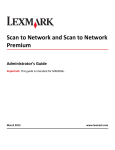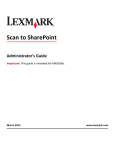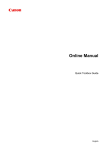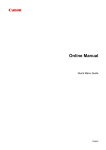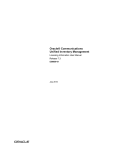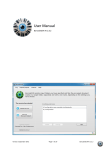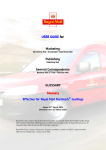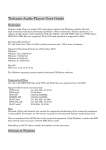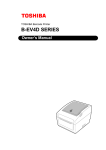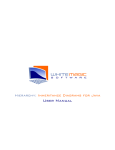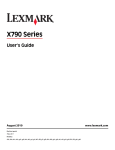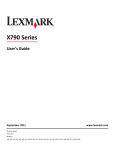Download Lexmark MX6500E User's Manual
Transcript
Bar Code Discovery Administrator's Guide Important: This guide is intended for MX6500e. March 2013 www.lexmark.com Contents 2 Contents Overview.....................................................................................................3 Optimizing bar code detection.....................................................................4 Optimizing bar code detection..................................................................................................................4 Configuring the application..........................................................................5 Configuring Bar Code Discovery................................................................................................................5 Notices.........................................................................................................7 Index..........................................................................................................12 Overview 3 Overview Bar Code Discovery lets you create and manage bar code templates to specify the location and type of bar code that users will frequently scan. Other applications such as Scan to Network Premium can then access these templates to reduce the amount of time it takes to scan and identify bar codes on a given scanner. This application supports the following bar code types: • • • • • • • • • • • • • • • • • • • • • • • • • • • • • • Code 11 Code 128 Code 32 Code 39 Code 93 Codabar Data Matrix EAN-13 EAN-13 plus 2 EAN-13 plus 5 EAN-8 EAN-8 plus 2 EAN-8 plus 5 Interleaved 2 of 5 ITF-14 Patch Code PDF 417 Planet PostNet QR RM4SCC RSS-14 RSS Limited Telepen UPC A UPC A plus 2 UPC A plus 5 UPC E UPC E plus 2 UPC E plus 5 Optimizing bar code detection 4 Optimizing bar code detection Optimizing bar code detection Tips on scanning bar codes • When scanning one-dimensional bar codes, position them horizontally to match the linear scaling of the bars. • If patterns of text and specks are falsely detected as bar codes, then you can choose to ignore those areas, or you can rescan the page. • If the bar code is skewed on the page itself, then position the page in such a way that the bar code is aligned horizontally or vertically with the scanner. This is particularly helpful when scanning two-dimensional bar codes, such as PDF417, Data Matrix, and QR codes, which are harder to recognize than basic one-dimensional bar codes, such as Code 3 of 9 and Code 128. Tips on designing bar codes • Increase the bar code font size to a more readable size. • Make sure asterisks appear before and after the bar code characters. Asterisks are used as start/stop characters for most linear bar codes. • Make sure that only valid bar code characters are used within the data. An invalid character may be recognized as a blank space, which will then result to having increased gaps between the bars. • Make sure that there is enough contrast between the bar code and the color of the material you are printing on. • Make sure to know the type, resolution, orientation, placement, and the number of bar codes on a document. These are significant factors that can affect bar code detection. • To prevent patterns of text and specks from appearing as bar codes in some documents, make sure to establish a quiet zone (a clear area without any text or other marks) around the bar code. Configuring the application 5 Configuring the application Configuring Bar Code Discovery Bar Code Discovery is accessed from the home screen. Creating a bar code template Automatic bar code discovery recognizes the most common bar code types and orientations on A4‑ or letter‑size paper. If you are using a paper size other than A4 or letter or if the bar code is not recognized automatically, then you can search for bar codes manually. To search for bar codes automatically 1 Load a document containing the bar code faceup, short edge first into the automatic document feeder (ADF) or facedown on the scanner glass. Notes: • Make sure the Adjust ADF Skew option is off on the scan settings. • Make sure to position the bar codes horizontally. 2 From the home screen, touch Bar Code Discovery. 3 Touch Automatic bar code discovery. The page is searched for bar codes. If automatic bar code discovery fails, then you can search for bar codes manually. Note: Automatic Configuration searches for codes oriented at 0 degrees and 90 degrees. 4 Touch the bar code you want to configure, and then touch Configure. Note: If you do not want a bar code to appear in the template, touch the bar code, and then select Ignore this bar code. 5 Follow the on‑screen prompts to type a name for the bar code, set an optional delimiter, and assign optional field names. Note: Use a delimiter if the bar code contains multiple pieces of information that you want to identify separately, such as first and last names. The delimiter is the space or character that separates two or more fields within the bar code. If the template will be used to create files, then make sure not to use invalid characters, such as \ / :*?”<>| for a Windows file name. 6 Repeat step 4 through step 5 for any additional bar codes that appear on the page, and then touch Next.. 7 Type a name for the template, and then touch Next. 8 Confirm that the template is correct, and then touch Save. To search for bar codes manually 1 Load a document containing the bar code faceup, short edge first into the ADF or facedown on the scanner glass. 2 From the home screen, touch Bar Code Discovery. 3 Touch Configure bar code discovery. Configuring the application 6 4 Follow the on‑screen prompts to select the paper size and paper orientation. The page is then scanned. Note: Manual configuration searches for codes oriented at 0, 90, 180, and 270 degrees. 5 From the scan preview, select the area or areas where the bar code appears. 6 If you know the bar code type, then touch Specific bar code types to select the bar code type from the list. If you do not know the bar code type, then touch All bar code types. 7 Touch Next. The page is searched for bar codes. 8 Touch the bar code you want to configure, and then touch Configure. Note: If you do not want a bar code to appear in the template, then touch the bar code, and then select Ignore this bar code. 9 Follow the on‑screen prompts to type a name for the bar code, set an optional delimiter, and assign optional field names. Note: Use a delimiter if the bar code contains multiple pieces of information that you want to identify, such as first and last names. The delimiter is the space or character that separates the two or more fields within the bar code. If the template will be used to create files, then make sure not to use invalid characters, such as \ / :*?”<>| for a Windows file name. 10 Repeat step 8 through step 9 for any additional bar codes that appear on the page, and then touch Next. 11 Type a name for the template, and then touch Next. 12 Confirm that the template is correct, and then touch Save. Note: If the bar code cannot be found, then the bar code is either damaged or not supported. Deleting a bar code template 1 From the home screen, touch Bar Code Discovery. 2 Touch Manage bar code templates. 3 Touch the template you want to delete. 4 Touch Delete, and then follow the prompts to complete the process. Notices 7 Notices Edition notice March 2013 The following paragraph does not apply to any country where such provisions are inconsistent with local law: LEXMARK INTERNATIONAL, INC., PROVIDES THIS PUBLICATION “AS IS” WITHOUT WARRANTY OF ANY KIND, EITHER EXPRESS OR IMPLIED, INCLUDING, BUT NOT LIMITED TO, THE IMPLIED WARRANTIES OF MERCHANTABILITY OR FITNESS FOR A PARTICULAR PURPOSE. Some states do not allow disclaimer of express or implied warranties in certain transactions; therefore, this statement may not apply to you. This publication could include technical inaccuracies or typographical errors. Changes are periodically made to the information herein; these changes will be incorporated in later editions. Improvements or changes in the products or the programs described may be made at any time. References in this publication to products, programs, or services do not imply that the manufacturer intends to make these available in all countries in which it operates. Any reference to a product, program, or service is not intended to state or imply that only that product, program, or service may be used. Any functionally equivalent product, program, or service that does not infringe any existing intellectual property right may be used instead. Evaluation and verification of operation in conjunction with other products, programs, or services, except those expressly designated by the manufacturer, are the user’s responsibility. For Lexmark technical support, visit http://support.lexmark.com. For information on supplies and downloads, visit www.lexmark.com. © 2013 Lexmark International, Inc. All rights reserved. Trademarks Lexmark and Lexmark with diamond design are trademarks of Lexmark International, Inc., registered in the United States and/or other countries. All other trademarks are the property of their respective owners. GOVERNMENT END USERS The Software Program and any related documentation are "Commercial Items," as that term is defined in 48 C.F.R. 2.101, "Computer Software" and "Commercial Computer Software Documentation," as such terms are used in 48 C.F.R. 12.212 or 48 C.F.R. 227.7202, as applicable. Consistent with 48 C.F.R. 12.212 or 48 C.F.R. 227.7202-1 through 227.7207-4, as applicable, the Commercial Computer Software and Commercial Software Documentation are licensed to the U.S. Government end users (a) only as Commercial Items and (b) with only those rights as are granted to all other end users pursuant to the terms and conditions herein. This product includes software developed by the Apache Software Foundation (http://www.apache.org). Notices 8 The Apache Software License, Version 1.1 Copyright (c) 2000-2002 The Apache Software Foundation. All rights reserved. Redistribution and use in source and binary forms, with or without modification, are permitted provided that the following conditions are met: 1 Redistributions of source code must retain the above copyright notice, this list of conditions and the following disclaimer. 2 Redistributions in binary form must reproduce the above copyright notice, this list of conditions and the following disclaimer in the documentation and/or other materials provided with the distribution. 3 The end-user documentation included with the redistribution, if any, must include the following acknowledgment: "This product includes software developed by the Apache Software Foundation (http://www.apache.org/)." Alternately, this acknowledgment may appear in the software itself, if and wherever such third-party acknowledgments normally appear. 4 The names "Apache" and "Apache Software Foundation", "Jakarta-Oro" must not be used to endorse or promote products derived from this software without prior written permission. For written permission, please contact [email protected]. 5 Products derived from this software may not be called "Apache" or "Jakarta-Oro", nor may "Apache" or "JakartaOro" appear in their name, without prior written permission of the Apache Software Foundation. THIS SOFTWARE IS PROVIDED ``AS IS'' AND ANY EXPRESSED OR IMPLIED WARRANTIES, INCLUDING, BUT NOT LIMITED TO, THE IMPLIED WARRANTIES OF MERCHANTABILITY AND FITNESS FOR A PARTICULAR PURPOSE ARE DISCLAIMED. IN NO EVENT SHALL THE APACHE SOFTWARE FOUNDATION OR ITS CONTRIBUTORS BE LIABLE FOR ANY DIRECT, INDIRECT, INCIDENTAL, SPECIAL, EXEMPLARY, OR CONSEQUENTIAL DAMAGES (INCLUDING, BUT NOT LIMITED TO, PROCUREMENT OF SUBSTITUTE GOODS OR SERVICES; LOSS OF USE, DATA, OR PROFITS; OR BUSINESS INTERRUPTION) HOWEVER CAUSED AND ON ANY THEORY OF LIABILITY, WHETHER IN CONTRACT, STRICT LIABILITY, OR TORT (INCLUDING NEGLIGENCE OR OTHERWISE) ARISING IN ANY WAY OUT OF THE USE OF THIS SOFTWARE, EVEN IF ADVISED OF THE POSSIBILITY OF SUCH DAMAGE. ==================================================================== This software consists of voluntary contributions made by many individuals on behalf of the Apache Software Foundation. For more information on the Apache Software Foundation, please see http://www.apache.org/ Apache License Version 2.0, January 2004 http://www.apache.org/licenses/ TERMS AND CONDITIONS FOR USE, REPRODUCTION, AND DISTRIBUTION 1 Definitions. "License" shall mean the terms and conditions for use, reproduction, and distribution as defined by Sections 1 through 9 of this document. "Licensor" shall mean the copyright owner or entity authorized by the copyright owner that is granting the License. "Legal Entity" shall mean the union of the acting entity and all other entities that control, are controlled by, or are under common control with that entity. For the purposes of this definition, "control" means (i) the power, direct or indirect, to cause the direction or management of such entity, whether by contract or otherwise, or (ii) ownership of fifty percent (50%) or more of the outstanding shares, or (iii) beneficial ownership of such entity. "You" (or "Your") shall mean an individual or Legal Entity exercising permissions granted by this License. Notices 9 "Source" form shall mean the preferred form for making modifications, including but not limited to software source code, documentation source, and configuration files. "Object" form shall mean any form resulting from mechanical transformation or translation of a Source form, including but not limited to compiled object code, generated documentation, and conversions to other media types. "Work" shall mean the work of authorship, whether in Source or Object form, made available under the License, as indicated by a copyright notice that is included in or attached to the work (an example is provided in the Appendix below). "Derivative Works" shall mean any work, whether in Source or Object form, that is based on (or derived from) the Work and for which the editorial revisions, annotations, elaborations, or other modifications represent, as a whole, an original work of authorship. For the purposes of this License, Derivative Works shall not include works that remain separable from, or merely link (or bind by name) to the interfaces of, the Work and Derivative Works thereof. "Contribution" shall mean any work of authorship, including the original version of the Work and any modifications or additions to that Work or Derivative Works thereof, that is intentionally submitted to Licensor for inclusion in the Work by the copyright owner or by an individual or Legal Entity authorized to submit on behalf of the copyright owner. For the purposes of this definition, "submitted" means any form of electronic, verbal, or written communication sent to the Licensor or its representatives, including but not limited to communication on electronic mailing lists, source code control systems, and issue tracking systems that are managed by, or on behalf of, the Licensor for the purpose of discussing and improving the Work, but excluding communication that is conspicuously marked or otherwise designated in writing by the copyright owner as "Not a Contribution." "Contributor" shall mean Licensor and any individual or Legal Entity on behalf of whom a Contribution has been received by Licensor and subsequently incorporated within the Work. 2 Grant of Copyright License. Subject to the terms and conditions of this License, each Contributor hereby grants to You a perpetual, worldwide, non-exclusive, no-charge, royalty-free, irrevocable copyright license to reproduce, prepare Derivative Works of, publicly display, publicly perform, sublicense, and distribute the Work and such Derivative Works in Source or Object form. 3 Grant of Patent License. Subject to the terms and conditions of this License, each Contributor hereby grants to You a perpetual, worldwide, non-exclusive, no-charge, royalty-free, irrevocable (except as stated in this section) patent license to make, have made, use, offer to sell, sell, import, and otherwise transfer the Work, where such license applies only to those patent claims licensable by such Contributor that are necessarily infringed by their Contribution(s) alone or by combination of their Contribution(s) with the Work to which such Contribution(s) was submitted. If You institute patent litigation against any entity (including a cross-claim or counterclaim in a lawsuit) alleging that the Work or a Contribution incorporated within the Work constitutes direct or contributory patent infringement, then any patent licenses granted to You under this License for that Work shall terminate as of the date such litigation is filed. 4 Redistribution. You may reproduce and distribute copies of the Work or Derivative Works thereof in any medium, with or without modifications, and in Source or Object form, provided that You meet the following conditions: a (a) You must give any other recipients of the Work or Derivative Works a copy of this License; and b (b) You must cause any modified files to carry prominent notices stating that You changed the files; and c (c) You must retain, in the Source form of any Derivative Works that You distribute, all copyright, patent, trademark, and attribution notices from the Source form of the Work, excluding those notices that do not pertain to any part of the Derivative Works; and d (d) If the Work includes a "NOTICE" text file as part of its distribution, then any Derivative Works that You distribute must include a readable copy of the attribution notices contained within such NOTICE file, excluding those notices that do not pertain to any part of the Derivative Works, in at least one of the following places: within a NOTICE text file distributed as part of the Derivative Works; within the Source form or documentation, if provided along with the Derivative Works; or, within a display generated by the Derivative Works, if and wherever such third-party notices normally appear. The contents of the NOTICE file are for informational purposes only and do not modify the License. You may add Your own attribution notices within Derivative Works Notices 10 that You distribute, alongside or as an addendum to the NOTICE text from the Work, provided that such additional attribution notices cannot be construed as modifying the License. 5 6 7 8 9 You may add Your own copyright statement to Your modifications and may provide additional or different license terms and conditions for use, reproduction, or distribution of Your modifications, or for any such Derivative Works as a whole, provided Your use, reproduction, and distribution of the Work otherwise complies with the conditions stated in this License. Submission of Contributions. Unless You explicitly state otherwise, any Contribution intentionally submitted for inclusion in the Work by You to the Licensor shall be under the terms and conditions of this License, without any additional terms or conditions. Notwithstanding the above, nothing herein shall supersede or modify the terms of any separate license agreement you may have executed with Licensor regarding such Contributions. Trademarks. This License does not grant permission to use the trade names, trademarks, service marks, or product names of the Licensor, except as required for reasonable and customary use in describing the origin of the Work and reproducing the content of the NOTICE file. Disclaimer of Warranty. Unless required by applicable law or agreed to in writing, Licensor provides the Work (and each Contributor provides its Contributions) on an "AS IS" BASIS, WITHOUT WARRANTIES OR CONDITIONS OF ANY KIND, either express or implied, including, without limitation, any warranties or conditions of TITLE, NONINFRINGEMENT, MERCHANTABILITY, or FITNESS FOR A PARTICULAR PURPOSE. You are solely responsible for determining the appropriateness of using or redistributing the Work and assume any risks associated with Your exercise of permissions under this License. Limitation of Liability. In no event and under no legal theory, whether in tort (including negligence), contract, or otherwise, unless required by applicable law (such as deliberate and grossly negligent acts) or agreed to in writing, shall any Contributor be liable to You for damages, including any direct, indirect, special, incidental, or consequential damages of any character arising as a result of this License or out of the use or inability to use the Work (including but not limited to damages for loss of goodwill, work stoppage, computer failure or malfunction, or any and all other commercial damages or losses), even if such Contributor has been advised of the possibility of such damages. Accepting Warranty or Additional Liability. While redistributing the Work or Derivative Works thereof, You may choose to offer, and charge a fee for, acceptance of support, warranty, indemnity, or other liability obligations and/or rights consistent with this License. However, in accepting such obligations, You may act only on Your own behalf and on Your sole responsibility, not on behalf of any other Contributor, and only if You agree to indemnify, defend, and hold each Contributor harmless for any liability incurred by, or claims asserted against, such Contributor by reason of your accepting any such warranty or additional liability. END OF TERMS AND CONDITIONS APPENDIX: How to apply the Apache License to your work. To apply the Apache License to your work, attach the following boilerplate notice, with the fields enclosed by brackets "[]" replaced with your own identifying information. (Don't include the brackets!) The text should be enclosed in the appropriate comment syntax for the file format. We also recommend that a file or class name and description of purpose be included on the same "printed page" as the copyright notice for easier identification within third-party archives. Copyright [yyyy] [name of copyright owner] Licensed under the Apache License, Version 2.0 (the "License"); you may not use this file except in compliance with the License. You may obtain a copy of the License at http://www.apache.org/licenses/LICENSE-2.0 Unless required by applicable law or agreed to in writing, software distributed under the License is distributed on an "AS IS" BASIS, WITHOUT WARRANTIES OR CONDITIONS OF ANY KIND, either express or implied. See the License for the specific language governing permissions and limitations under the License. Notices GNU Lesser General Public License View the GNU Lesser General Public License online at http://www.gnu.org/licenses/lgpl.html. View the LGPL licensed source code online at ftp.lexmark.com/eSF/source.zip. 11 Index Index B bar code detection optimizing 4 Bar Code Discovery configuring 5 overview 3 bar code template adding 5 configuring automatically 5 configuring manually 5 deleting 6 D designing bar codes tips on 4 N notices 7 O overview Bar Code Discovery 3 S scanning bar codes tips on 4 12












